Skip to comments.
Dominican rite aims to shine from the ‘dark ages’
CNA ^
| November 23, 2008
| Patricia Coll Freeman
Posted on 11/24/2008 1:16:30 PM PST by NYer
Anchorage, Nov 23, 2008 / 02:56 pm (CNA).- Beginning December 6, ethereal chant, incense and perhaps even an ostrich-feathered liturgical fan will waft through Holy Family Cathedral in Anchorage, Alaska as the archdiocese prepares for the ancient Dominican rite Mass that will be celebrated in Latin every first Saturday of the month at noon.
The Catholic Anchor reports that the successful emergence of the Dominican rite locally is keeping the tradition alive, and perhaps fueling organic development of the liturgy into the future.
By early 2009, the Anchorage Archdiocese is also hoping to provide regular celebrations of the Tridentine Latin Mass, which was the standard Roman Catholic liturgy before the Second Vatican Council (1962-65).
A question of rites
Within the universal Catholic Church, there are 22 different rites, such as the Roman, Byzantine and Coptic, that incorporate different traditions into the Mass.
When it comes to forms of the Mass, “often we think of the Masses as ‘pre-Vatican II’ and ‘post-Vatican II,’ and it was more complicated than that,” said Father Vincent Kelber — a Dominican priest at Holy Family Cathedral, where he is preparing to celebrate the Dominican rite.
In 1570, the Council of Trent codified the Tridentine Mass as “the Mass for all time,” he explained. It then served as the main form of the Mass for the Latin Church until the Second Vatican Council.
The Council of Trent, however, allowed for the celebration of those rites which, at the time, had been in existence for at least 200 years, Father Kelber said.
That meant the Dominican order and others like the Carthusians, Cistercians and Carmelites could continue celebrating their own rites, alongside the principal Tridentine Mass.
Father Kelber explained that by the 1200s, it was clear that the Dominicans needed a common liturgical expression for the order’s many priests who preached and celebrated Mass in varied communities across Europe. Thus, the Dominican rite was established.
While the Tridentine Mass is sometimes criticized for being antiquated, it is actually pretty new compared to the medieval Dominican rite, noted Father Kelber. The Tridentine is really “the beginning of the modern era,” he said.
At Vatican II, the Tridentine Mass was replaced by the “Novus Ordo” or “new Ordinary of the Mass” as the principal form of the Mass. In that form, which most Catholics are accustomed to today, prayers are said in the local language.
Ancient is new again
Those familiar with the Tridentine Mass will find similarities in the Dominican rite. Both are celebrated in Latin, which for centuries was the sacred liturgical language of the Catholic Church, Father Kelber said.
Additionally, in both the Tridentine and Dominican rites, priests face the same direction as the congregation — toward the altar.
The point is to be “oriented towards the one God,” said Father Kelber. The Eucharist is always central, he added.
Priests also wear special vestments in the Dominican rite, but since the Dominicans “pre-date lace,” explained Father Kelber, they are not as ornate as those in the Tridentine rite.
Catholics may also notice that the Dominican rite contains many signs of reverence, such as bowing, Father Kelber explained.
A penitential prayer, which the priest leads at the start of the Mass, is said before he enters into the sanctuary, “the holy of holies,” Father Kelber said. Also, communicants receive Communion kneeling.
“Every movement in the Mass is purposeful and prayerful; it is embodied worship,” he said.
‘Rite’ for the times
While Vatican II ushered in many needed changes, the continued use of the Dominican rite helped provide stability amid the flux.
“We realize now and Pope Benedict realizes that some of the changes of the Second Vatican Council were good, but some of them were too fast, some weren’t explained, some were poorly implemented and some weren’t according to the documents,” Father Kelber said.
The ancient Masses “helped people to cope,” he added.
As part of the patrimony of the church, the ancient Mass is worth preserving, Father Kelber continued.
“It’s okay to have this kind of diversity,” he said.
Father Kelber said it is especially important to appreciate the “ethos” of a pre-reformation tradition, such as that of the Dominicans.
“There is a lot that the medieval times can offer,” he said. “They weren’t in the dark ages at all. They lived a life that we can see today is something worth emulating in many ways, because it was before the busy-ness of the modern world. They knew what contemplation was, they knew what silence was, and we don’t.”
An ancient rite blooms
In the 1980s interest in the Dominican rite grew among the young friars of the Dominicans’ Western Province, said Father Kelber. Interest “bloomed again in a new way” with friars, such as Father Kelber, who were ordained in the late 1990s and early 21-century.
With no formal training on how to celebrate the ancient Mass, Father Kelber said he read about the Mass and worked with other priests familiar with it.
“Preservation work is personal,” he said. “It has to be handed-down. It can’t be just gotten out of a book.”
Now, given the growing interest in the Dominican rite, the Western and Eastern Provinces of the Dominican order are planning instructive conferences for its friars. The first takes place August 2009 at St. Albert’s priory in Oakland.
Here in Anchorage, with permission from his provincial director and Anchorage Archbishop Roger Schwietz, Father Kelber has been perfecting his practice of the Dominican rite on his days off.
“There are people all over the United States and the world excited about the old rite — excited about Gregorian chant,” he said. “It’s not just one person here saying ‘Well, I miss the old days.’ It’s not just something looking back, but something looking forward and a gift for these crazy times.”
TOPICS: Catholic; History; Worship
KEYWORDS: ak; catholic; dominican; dominicanrite; rite
Navigation: use the links below to view more comments.
first 1-20, 21-40, 41-60, 61-80 ... 121-129 next last
1
posted on
11/24/2008 1:16:30 PM PST
by
NYer
To: Salvation; narses; SMEDLEYBUTLER; redhead; Notwithstanding; nickcarraway; Romulus; ...
And from the New Liturgical Movement blog, here is some additional information.
The Dominican Rite: A Summary
by Shawn Tribe
[Summary and simplification from 1917 Catholic Encyclopedia)
Origin and development
The question of a special unified rite for the order received no official attention in the time of St. Dominic, each province sharing in the general liturgical diversities prevalent throughout the Church at the order's confirmation in 1216. Hence, each province and often each convent had certain peculiarities in the text and in the ceremonies of the Holy Sacrifice and the recitation of the Office.
The first indication of an effort to regulate liturgical conditions was manifested by Jordan of Saxony, the successor of St. Dominic.
The first systematic attempt at reform was made under the direction of John the Teuton, the fourth master general of the order. At his suggestion the Chapter of Bologna (1244) asked the delegates to bring to the next chapter (Cologne, 1245) their special rubrics for the recitation of the Office, their Missals, Graduals and Antiphonaries, "pro concordando officio". To bring some kind of order out of chaos a commission was appointed consisting of four members, one each from the Provinces of France, England, Lombardy, and Germany, to carry out the revision at Angers. They brought the result of their labours to the Chapter of Paris (1246), which approved the compilation and ordered its exclusive use by the whole Order and approved the "Lectionary" which had been entrusted to Humbert of Romains for revision.
Another force preservative of the special Dominican Rite was the Decree of Pius V (1570), imposing a common rite on the universal Church but excepting those rites which had been approved for two hundred years. This exception gave to the Order of Friars Preachers the privilege of maintaining its old rite, a privilege which the chapters of the order sanctioned and the members of the order gratefully accepted.
Several times movements have been started with the idea of conforming with the Roman Rite; but these have always been defeated, and the order still preserves the rite conceded to it by Pope Clement in 1267. [NLM: until our own modern day of course with the adoption of the Pauline Missal by the Dominican Order]
The Dominican Rite, formulated by Humbert, saw no radical development after its confirmation by Clement IV. When Pius V made his reform, the Dominican Rite had been fixed and stable for over three hundred years, while a constant liturgical change had been taking place in other communities. Furthermore the comparative simplicity of the Dominican Rite, as manifested in the different liturgical books, gives evidence of its antiquity.
The collection of the liturgical books now contains: (1) Martyrology; (2) Collectarium; (3) Processional; (4) Antiphonary; (5) Gradual; (6) Missal for the conventual Mass; (7) Missal for the private Mass; (8) Breviary; (9) Vesperal; (10) Horæ Diurnæ; (11) Ceremonial.
With the exception of the Breviary, these books are similar in arrangement to the correspondingly named books of the Roman Rite.
Dominican Liturgical Year
The Dominican Breviary is divided into Part I, Advent to Trinity, and Part II, Trinity to Advent. Also, unlike the Tridentine usage of the Roman rite and similar to the Sarum rite and other Northern European usages of the Roman rite, the Dominican Missal and Breviary counts Sundays after Trinity rather than Pentecost.
The Dominican Missal (Missale Sacri Ordinis Praedicatorum)
The most important is in the manner of celebrating a low Mass. The celebrant in the Dominican Rite wears the amice over his head until the beginning of Mass, and prepares the chalice as soon as he reaches the altar. The Psalm "Judica me Deus" is not said and the Confiteor, much shorter than the Roman, contains the name of St. Dominic. The Gloria and the Credo are begun at the centre of the altar and finished at the Missal. At the Offertory there is a simultaneous oblation of the Host and the chalice and only one prayer, the "Suscipe Sancta Trinitas". The Canon of the Mass is the same as the Canon of the Roman Rite, but after it are several noticeable differences. The Dominican celebrant says the "Agnus Dei" immediately after the "Pax Domini" and then recites the prayers "Hæc sacrosancta commixtio", "Domine Jesu Christe" and "Corpus et sanguis", then follows the Communion, the priest receiving the Host from his left hand. No prayers are said at the consumption of the Precious Blood, the first prayer after the "Corpus et Sanguis" being the Communion. These are the most noticeable differences in the celebration of a low Mass.
In a solemn Mass the chalice is brought in procession to the altar during the Gloria, and the corporal is unfolded by the deacon during the singing of the Epistle. The chalice is prepared just after the subdeacon has sung the Epistle, with the ministers seated at the Epistle side of the sanctuary. The chalice is brought from the altar to the place where the celebrant is seated by the sub-deacon, who pours the wine and water into it and replaces it on the altar. The incensing of the ministers occurs during the singing of the Preface. Throughout the rite the ministers also stand or move into various paterns rather different those of the old Roman Liturgy.
[Some pictures of the Mass according to the Dominican rite.]
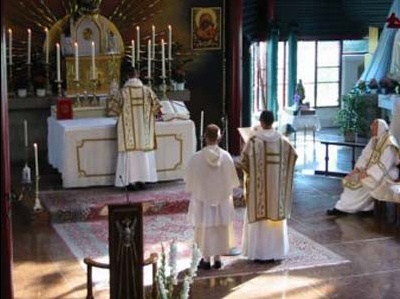
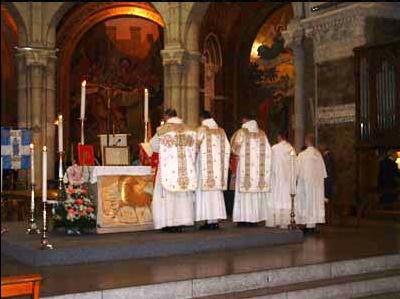
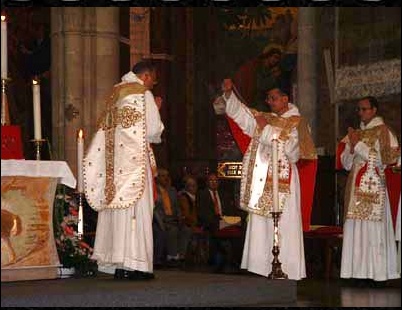
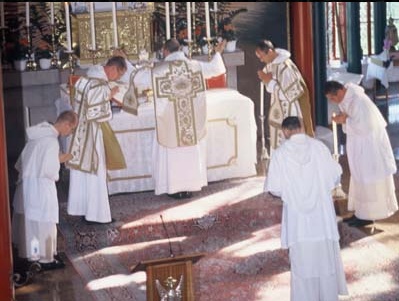
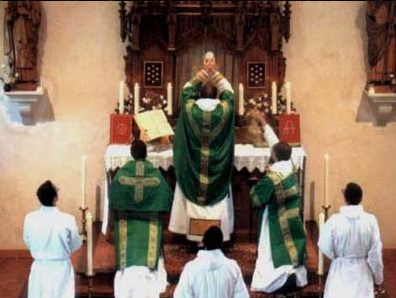 The Dominican Breviary (Brevarium Sacri Ordinis Praedicatorum)
The Dominican Breviary (Brevarium Sacri Ordinis Praedicatorum)
[NLM: there is a difference between the breviary used before Pius X's reform, and shortly thereafter. Someone here referenced Bonniwell's history of the Dominican liturgy, and I believe the date given for the reform of the Dominican Breviary came in the 1920's. This source is the 1917 Catholic Encyclopedia. It would be good to confirm whether this description speaks of the Dominican breviary prior to, or after in response to Pius X's reform of the breviary.]
The Dominican Breviary differs but slightly from the Roman. The Offices celebrated are of seven classes: of the season (de tempore), of saints (de sanctis), of vigils, of octaves, votive Offices, Office of the Blessed Virgin, and Office of the Dead. In point of dignity the feasts are classified as "totum duplex", "duplex" "simplex" "of three lessons", and "of a memory".
There is no difference in the ordering of the canonical hours, except that all during Paschal time the Dominican Matins provide for only three psalms and three lessons instead of the customary nine psalms and nine lessons.
The Office of the Blessed Virgin must be said on all days on which feasts of the rank of duplex or "totum duplex" are not celebrated. The Gradual psalms must be said on all Saturdays on which is said the votive Office of the Blessed Virgin. The Office of the Dead must be said once a week except during the week following Easter and the week following Pentecost. Other minor points of difference are the manner of making the commemorations, the text of the hymns, the Antiphons, the lessons of the common Offices and the insertions of special feasts of the order.
There is no great distinction between the musical notation of the Dominican Gradual, Vesperal and Antiphonary and the corresponding books of the Vatican edition. The Dominican chant has been faithfully copied from the MSS. of the thirteenth century, which were in turn derived indirectly from the Gregorian Sacramentary. One is not surprised therefore at the remarkable similarity between the chant of the two rites.
2
posted on
11/24/2008 1:18:36 PM PST
by
NYer
("Run from places of sin as from a plague." - St. John Climacus)
To: NYer
So many countries with starvation, over-population and murderous governments and THIS is what the Church is busy doing.
No different than AIG.
3
posted on
11/24/2008 1:21:37 PM PST
by
HappyinAZ
To: HappyinAZ
The Church is capable of doing far more than one thing at a time.
4
posted on
11/24/2008 1:26:27 PM PST
by
DuncanWaring
(The Lord uses the good ones; the bad ones use the Lord.)
To: DuncanWaring
5
posted on
11/24/2008 1:27:27 PM PST
by
HappyinAZ
To: HappyinAZ
What could be more efficatous in solving these problems that worshiping God.
6
posted on
11/24/2008 1:30:06 PM PST
by
Klondike
To: Klondike
let’s see...might want to roll up their sleeves and put ALL the money they wasted on silk robes into helping the poor.
7
posted on
11/24/2008 1:33:08 PM PST
by
HappyinAZ
To: HappyinAZ
The Church currently operates over 500 hospitals and over 1,500 charitable organizations in the United States alone. You sir are an idiot of monumental proportions.
8
posted on
11/24/2008 1:33:59 PM PST
by
Namyak
(Oderint dum metuant)
To: Namyak
a mirror is called for. Dump the silk/dump the palaces/dump the pomp and circumstance and use that money...every dime...for the poor. They can do better.
9
posted on
11/24/2008 1:37:23 PM PST
by
HappyinAZ
To: HappyinAZ
Reread how Our Lord treated Judas Iscariot when he made pretty much your same point.
10
posted on
11/24/2008 1:37:35 PM PST
by
Pyro7480
(This Papist asks everyone to continue to pray the Rosary for our country!)
To: HappyinAZ
That’s the first step in egalitarianism, whether you acknowledge it or not.
11
posted on
11/24/2008 1:38:28 PM PST
by
Pyro7480
(This Papist asks everyone to continue to pray the Rosary for our country!)
To: Pyro7480
The truth hurts doesn’t it. They can do better....much better.
To: Namyak
You’re wasting your time. Check the post history on the Kathleen Parker thread.
13
posted on
11/24/2008 1:39:08 PM PST
by
NinoFan
To: HappyinAZ
Have you given everything you own to the poor?
14
posted on
11/24/2008 1:39:58 PM PST
by
Tax-chick
("And the LORD alone will be exalted in that day." (Is. 2)
To: HappyinAZ
Only an anti-Christian would say “the truth hurts doesn’t it” when talking about Judad.
It’s not your call to make. Take your anti-Christian blather elsewhere.
15
posted on
11/24/2008 1:40:21 PM PST
by
NinoFan
To: Pyro7480
Jesus didn’t have the silk...or the pomp...or the circumstance...or the palace...
Time for the church to get back to basics.
To: HappyinAZ
Get the beam out of your eye. What is YOUR church doing?
17
posted on
11/24/2008 1:43:45 PM PST
by
Pyro7480
(This Papist asks everyone to continue to pray the Rosary for our country!)
To: NYer
Thank you to NYer for posting this. I suggest that we all get back to the topic of this thread. Ignore those who would derail its purpose. It’s tempting to respond (I fell for it as well), but it has nothing to do with the actual topic at hand. :)
18
posted on
11/24/2008 1:44:03 PM PST
by
NinoFan
To: Pyro7480
I see...when one can’t argue the facts...on re-directs.
I repeat...Jesus didn’t have all the silk/and related nonsense...time to get back to basics.
To: HappyinAZ
Jesus didn’t need them because He had the inherent dignity of His perfect humanity and His adorable divinity. But He still praised the woman who spent a costly sum on the perfume in the alabaster jar.
20
posted on
11/24/2008 1:45:44 PM PST
by
Pyro7480
(This Papist asks everyone to continue to pray the Rosary for our country!)
Navigation: use the links below to view more comments.
first 1-20, 21-40, 41-60, 61-80 ... 121-129 next last
Disclaimer:
Opinions posted on Free Republic are those of the individual
posters and do not necessarily represent the opinion of Free Republic or its
management. All materials posted herein are protected by copyright law and the
exemption for fair use of copyrighted works.
FreeRepublic.com is powered by software copyright 2000-2008 John Robinson




